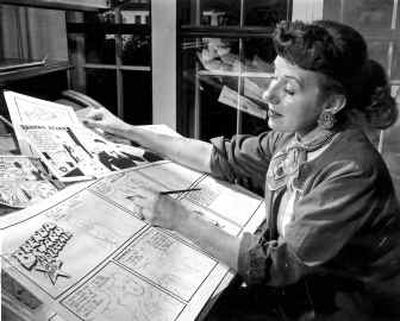Female comics pioneer Messick dies at 98

NEW YORK – Dale Messick, a trailblazing female cartoonist whose popular strip, “Brenda Starr, Reporter,” helped break men’s hold on the funny pages, has died at age 98.
Messick, who was hired by New York Daily News Publisher Joseph M. Patterson in 1940, died Tuesday at home in Northern California, said her daughter, Starr Rohrman.
“She was a dominant force and paved the way for a lot of women,” said Mort Walker, the creator of “Beetle Bailey.” “It showed the power of women in a way people weren’t used to seeing.”
Mixing hot copy with high fashion, Brenda plunged from one thrilling adventure to another.
She shamelessly sassed her tough-talking editor, Mr. Livwright, and dated the handsome Basil St. John, who wore an eye patch and suffered from a mysterious disease that could be cured only with a rare Amazon herb.
As World War II raged, Brenda parachuted into action – every red hair in place.
“Most comics, they don’t write for women,” Messick once said. “I was writing for women, and I think that’s what put her over.”
Messick once said Brenda had “everything I didn’t have.” But the cartoonist had a spunk and style worthy of her red-headed creation even as she neared the century mark.
Born in South Bend, Ind., on April 11, 1906, with the name Dalia – a moniker she jettisoned to further her career – Messick got her first job during the Depression as a greeting card writer.
She got a break when Patterson agreed to put Brenda Starr in the Chicago Tribune – but not initially in The News, allegedly because he was no fan of female cartoonists. It eventually would run in 250 papers.
Her famous character’s figure and flowing red hair were based on film star Rita Hayworth.
Messick later came under fire because Brenda was too preoccupied with her looks and removed from the routine of real newspaperwomen.
“Girl reporters (said) their lives were nowhere near as exciting as Brenda’s,” Messick once said. “I told them that if I made Brenda’s life like theirs, nobody would read it.”